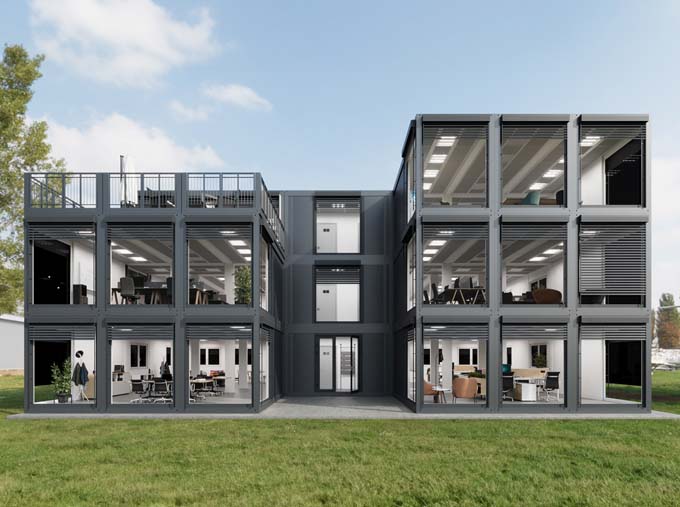Wood energy - even more efficient and even cleaner
How wood burns cannot be reinvented, one would think. Nevertheless, despite its millennia-old and globally practiced application, energy generation from wood still holds interesting innovations in store. For example, the speakers at the 15th Wood Energy Symposium held in mid-September in Zurich presented various approaches to making the generation of heat and electricity from wood even more efficient and even cleaner.

Not all wood is the same, even when it comes to wood combustion. There are more than half a million wood-burning appliances in Switzerland. The vast majority are fireplaces or tiled stoves. They provide comfortable room heat, but most people do not perceive them as devices for energy production. In contrast, a few tens of thousands of log boilers, pellet and woodchip furnaces, as well as several dozen large wood-fired power plants, are truly tailored to energy production. In this area of professional energy production - from a few to several thousand kW capacity - a continuous renewal process towards even more efficient and even less polluting plants is taking place.
A bouquet of innovations
The Wood Energy Symposium in mid-September vividly demonstrated this innovation process to around 150 participants. During half a day, researchers and industry representatives presented concepts, some of which have already proven themselves on the market. Michael Strassl (ETA Heiztechnik, Hofkirchen/A) reported on a new series of wood chip boilers in the lower output range (20 to 80 kW) that achieve low pollutant levels thanks to an integrated electrostatic particle filter, and this also in the ignition and ember burn-off phase. The device, of which 1000 units have already been delivered since 2016, is aimed primarily at forest owners who want to burn their own wood. Low emissions with high-ash fuels are also the aim of the novel screw grate firing system presented by Dr. Gabriel Barroso (Lucerne University of Applied Sciences and Arts - Technology&Architecture) for a Swiss-Austrian-Swedish project team with Schmid AG energy solutions as an industrial partner. In a research project by Dr. Mohammad Aleysa (Fraunhofer Institute for Building Physics, Stuttgart), the same goal is achieved by ceramic and metallic internals in the combustion chamber.
Better energy yield is the aim of the system called 'Neviro', which Rupert Kaindl (Kaindl Feuerungstechnik GmbH, Lachen/SZ) has developed together with the company OekoSolve AG (Mels-Plons/SG). Here, the hot exhaust gases are used to dry moist wood fuels before they enter the furnace. Wood with relatively high moisture content is also the fuel used to feed the new wood-fired cogeneration plant in Puidoux/VD. These are precisely the characteristics that the clients from the municipality of Puidoux wanted in order to be able to use local wood. The 4.5 MW plant can generate not only heat but also a comparatively large amount of electricity, the latter thanks to the combination of a combined heat and power plant and an ORC turbine, as Dr. Giulio Caimi (Romande Energie Services SA, Morges/VD) reported. Other innovations at the Wood Energy Symposium included very efficient heat storage systems using special storage media and a method for determining the energy content of wood chips (cf. SFOE technical article 'Soviel Energie steckt in Hackschnitzeln', available at www.bfe.admin.ch/CT/biomasse).
Using wood energy and other biomass for process heat
But what does Switzerland actually need wood energy for? Or rather: What is the best use of energy derived from wood as a sustainable energy source? This strategic question was addressed in his keynote speech by Prof. Hanspeter Eicher, co-founder and Chairman of the Board of Directors of the planning company eicher+pauli AG. Eicher put the long-term Swiss heat demand for space heating (approx. 35 °C), hot water (up to 60 °C) and process heat (up to 1000 °C) at 60 to 70 TWh per year, whereby this figure already takes into account the large savings potential in the area of space heating and the further increase in energy reference areas.
Eicher advocated using wood energy and the remaining biomass or energy sources derived from it for efficiency reasons in the longer term only to generate space heating where other energy sources are not available on site, such as heat from groundwater, lake and river water, waste heat from waste incineration plants or wastewater treatment. Wood and biomass are the only renewable energy sources that can be used to provide industrial process heat year-round, Eicher said, showing implemented examples of plants at Coop, Migros and Oberland Energie AG in Wimmis. "Around half of the wood currently used to generate heat in district heating networks should in future be used to generate process heat up to 300 °C or converted into electricity via combined heat and power plants," Eicher urged. If wood energy and other sustainably usable biomass were consistently used to provide process heat, about 80% of the current nationwide demand for process heat (26 TWh/a) could be met. This strategic consideration of Eicher's met with opposition at the Zurich meeting from Andreas Keel, managing director of Holzenergie Schweiz. There are 250,000 forest owners in Switzerland, Keel pointed out, and many of them want to produce heat for themselves from their own forests.
Pollutant reduction for small plants
At the Wood Energy Symposium, there was no disputing the great importance of wood, the second most important renewable energy source in Switzerland after water. The Federal Council's Energy Strategy 2050 envisages full utilization of the domestic potential, said Christoph Plattner, who until recently helped oversee the energy strategy at the Federal Office of Energy. Wood energy will continue to gain importance and "has good prospects for the future," Plattner said.
The energy expert stressed that the expansion of wood energy must take place "without additional immission pollution". In fact, the wood energy industry is confronted with legal requirements to further reduce the emission of solid and gaseous pollutants. In Zurich, Dr. Beat Müller of the Federal Office for the Environment presented the Ordinance on Air Pollution Control (LRV), which has been in force since June 2018 and which, in particular, tightens the requirements for smaller furnaces (under 70 kW) (including lower limits, visual inspections and periodic measurements). "The cantons are now challenged with enforcement," Müller said. At the same time, he announced more far-reaching regulations for the benefit of people and the environment: "We have not yet reached our goal with regard to wood-burning furnaces. The latest revision means a big step forward for small wood furnaces. Further steps will definitely follow."
New approach to ash disposal
The industry is also challenged in the disposal of ash. Wood-fired systems in Switzerland were responsible for 75,000 tons of wood ash in 2016. Since the beginning of 2016, the Ordinance on the Prevention and Disposal of Waste (VVEA) has described how this can be disposed of properly. At the time, the ordinance led to considerable enforcement problems. A revision became necessary shortly after it came into force. The Federal Council has now approved the revised VVEA in September 2018. Now a "practicable solution" is on the table, said Andreas Keel of Holzenergie Schweiz. At the same time, he informed about the HARVE project, with which not only regional disposal solutions but also new ways of recycling wood ash will be developed by 2020.
The conference documentation of the 2018 Wood Energy Symposium supported by the Swiss Federal Office of Energy can be found at: www.holzenergie-symposium.ch
For more technical papers on research, pilot, demonstration and lighthouse projects in the field of wood energy/bioenergy, see. www.bfe.admin.ch/CT/biomasse
Proper design of heat networks:
Wood energy is a popular form of energy for supplying heating networks. Thomas Nussbaumer (organizer of the Wood Energy Symposium, owner of the engineering firm Verenum and professor at the Lucerne University of Applied Sciences and Arts) presented in Zurich the EXCEL-based tool THENA (for: Thermal Network Analysis) for planning and evaluating district heating networks with up to 400 sub-lines. One basic rule, according to Nussbaumer, is that in order to build heating networks cost-effectively, the smallest permissible diameter should be selected for each sub-strand. (BV)









